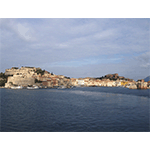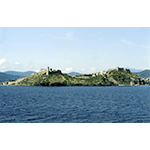Port and Defensive System of Portoferraio
In 1548, on the remains of the Roman Fabricia and the Medieval Ferraia (so called for being an important dock for the island’s iron mines), Cosimo I de’ Medici promoted the foundation of Portoferraio, thus marking a significant moment in the realisation of the regional state. "Cosmopolis", as the "city of Cosimo" was sometimes called or "Cosmo", from the allusion the Duke made to his name, was a point of reference in treatises dedicated to the criteria of constructing cities. It was indeed considered an excellent example of city-fortress in the Cosmografia Universalis by geographer Sebastiano Münster. In a letter to the Viceroy of Naples, dated April 16, 1548, Cosimo underlines the military and strategic character of the port: «The port of Elva … is of such importance that if it were occupied by a power desirous of troubling the affairs of Italy, it would find the easiest way to do as it pleases, for that site is strong by nature; the port capacious of any great armada and the site itself are near many places where damage could be done» (Historical Archive of Florence, Medici Archive of the Principality, File 11, c. 52). Sited behind a promontory, the port has a deep cove and a natural dock, defended by unassailable fortifications, which were built in the mid 16th century by military architects Giovan Battista Belluzzi and Giovanni Camerini. The defensive system was made up of a berthing front towards the west and three principal strongholds (Forte Falcone, Forte Stella and Fortezza della Linguella), interconnected by a system of bastions and walkways, so as to surround the entire surface area of the old city, at one time separated from the rest of the island by a manmade trench. The octagonal tower of Linguella, built at the mouth of the dock, is today the venue of the local Archaeological Museum, while Forte Stella houses one of the oldest lighthouses in Europe, built by Grand Duke Leopold of Lorraine in 1788.
The port also performed a leading role in the mining activities of the island, constituting one of the most important landing places for trading and transporting iron from the mines of Elba to the processing plants at Follonica. Furthermore, during the Lorraine period, numerous salterns were established in the port roadstead, which guaranteed one of the most important production activities of the Grand Duchy. In 1829, from these saline waters, chemist G.B. Pandolfini-Barbieri obtained a quantity of magnesium sulphate identical to that of Epsom salts.
Still today, it is possible to admire the Medici dock and the extraordinary defensive systems, which constitute a rare example of sixteenth-century maritime fortification.
****************************
Texts by Graziano Magrini
English translation by Victor Beard
Last update 12/feb/2008





